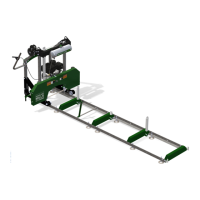
Do you have a question about the Takeuchi TB28FR and is the answer not in the manual?
| Brand | Takeuchi |
|---|---|
| Model | TB28FR |
| Category | Compact Excavator |
| Language | English |
Manual describes operation, inspection, maintenance, and safety instructions.
Describes the compartment for storing the manual and how to use it.
Instructions to check and write down machine and engine serial numbers.
Defines front, rear, left, and right based on operator's seat position.
Lists primary operations: Excavating, Digging ditches, Leveling, Loading.
Lists key features like offset boom, short tail swing, pilot controls, etc.
Instructions for the first 100 hours of operation for new machines.
General safety rules and precautions to observe.
Precautions to take before starting operation.
Precautions to follow when starting the machine.
Safety measures during machine operation.
Procedures for safely stopping the machine.
Safety guidelines for transporting the machine.
Safety measures during inspection and maintenance.
Identification and location of safety decals on the machine.
Identification of major machine components with numbered labels.
Information on opening and closing cab door, front window, side window.
Adjusting the operator's seat and fastening the seat belt.
Explanation of warning lamps, indicators, and meters on the dashboard.
Details on starter switch, horn, decel. switch, light, wiper switches.
Operation of safety lock lever, throttle, operating, travel levers, and pedals.
Information on cab heater, fan switch, outlets, and battery switch.
Daily and walk-around inspections before starting the engine.
Procedures for safely starting and stopping the engine.
Explanation of lever patterns and machine operations.
Guidelines for safe and efficient machine operations.
Procedures for safely parking the machine.
Precautions and preparations for operating in cold weather.
Cautions and prohibited actions to prevent crawler damage.
Safe procedures for loading and unloading the machine.
How to secure the machine on the transport vehicle.
Safety rules and laws to follow when transporting.
General principles for inspection and maintenance for long-term use.
Information on fuels, lubricants, greases, and expendables.
Schedule of maintenance tasks based on operating hours.
Daily walk-around inspection procedures.
Daily inspection tasks to be performed every 10 hours.
Maintenance tasks specific to new machines after 50 hours.
Maintenance tasks to be performed every 50 operating hours.
Maintenance tasks to be performed every 100 operating hours.
Maintenance tasks specific to new machines after 100-250 hours.
Maintenance tasks to be performed every 250 operating hours.
Maintenance tasks to be performed every 500 operating hours.
Maintenance tasks to be performed every 1000 operating hours.
Maintenance tasks to be performed every 2000 operating hours.
Maintenance tasks that should be performed as needed.
Procedures for storing the machine for extended periods.
Symptoms that may seem like malfunctions but are normal operation.
Symptoms and procedures for engine overheating.
Symptoms and procedures for a dead battery.
Procedures after the fuel runs out, including bleeding the fuel system.
Identifying blown fuses and their locations.
Procedures when warning lamps flash or alarms sound.
Troubleshooting for various other symptoms not covered elsewhere.
Procedure to manually lower the boom when the engine is stopped.
Key specifications of the machine, engine, and performance.
Detailed dimensions of the machine with diagrams.
Diagrams and dimensions of the machine's operating range.
Rated lift capacity charts for various configurations.
Safety precautions for installing optional attachments.
Information on keeping safety signs legible and replacing them.
How to change the operating pattern of the levers.
Handling and operating precautions for the hydraulic breaker.
Information on the 3-holes bucket and changing link arm position.